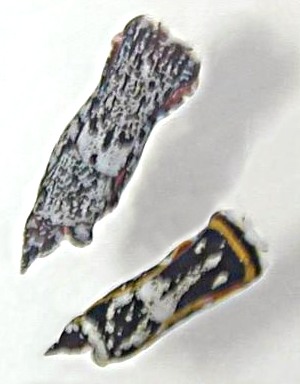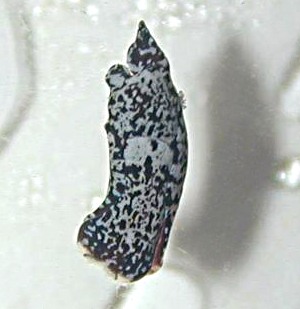Chelidonura berolina? from the Bahamas
April 14, 2003
From: Anne DuPont


Note added 15 March 2004: C. berolina = C. africana. See message #12457.
Bill,
I apologize for sending you photos that are so bad but hopefully you can use them for information purposes. I found them over a range of 100 miles in the Southern Bahamas (The Exumas chain of islands) in depths from 2 feet to 10 feet. [January - March, 2003]. Their size was 1/8 inch to about 1 inch long.
In the same area that I found the Philinopsis sp and the Chelidonura hirundinina and the small black Aglaja I kept seeing on the sand what looked like little black dots moving, and because they were so tiny could not tell what they were.
So I scooped up a couple and brought them to the boat, put them in a dish and tried to photograph them with the digital camera.
Are they Aglaja hummelincki? I'll send one more photo...
Cordially,
Anne
akdupont@bellsouth.net
DuPont, A., 2003 (Apr 14) Chelidonura berolina? from the Bahamas. [Message in] Sea Slug Forum. Australian Museum, Sydney. Available from http://www.seaslugforum.net/find/9573Dear Anne,
I know you didn't want me to post these but I they are too interesting to ignore. I am sure your animal is the same as the one that Tom Thompson (1977) reported from Jamaica and Colin Redfern (2001) reported from Barbados as Aglaja hummelincki Marcus & Marcus, 1970. However I think they have misidentified the species. Aglaja hummelincki was described from 3 preserved specimens 3-4mm long, collected in Puerto Rico. There is no description of their living colour, and preserved they were described as 'black and have small pigment free blotches on back and parapodia'. There is little very distinctive in their description of the shape of the body other than 'left caudal lobe bigger then right one; no flagellum..'. In a brief discussion Marcus & Marcus try to justify describing a species without any colour information by saying "the colour of the species of Aglaja seems variable and of doubtful value (White, 1946)". This is of course nonsense. It is true that some species are quite variable in colour, but it is our responsibility to make some effort to investigate that variability before we try defining our species. Basically the only similarities between Thompson's specimens and the description of A. hummelincki were that they were small and had a black background colour.
Surprisingly, there is another species described by Marcus & Marcus, in the same paper, which fits Thompson's, Redfern's and your animals very well. It is Chelidonura berolina. It was also collected in Puerto Rico and it is small (5-8mm long alive). It is described as "chocolate brown spekled with white. Brownish orange margins of parapodia [are] interrupted by patches of sea green speckles. A brownish orange band transverses anterior part of head shield ... Left posterior mantle lobe long, pointed, right one shorter, rounded ...". Surprisingly, Marcus & Marcus contradict their earlier statement that colour is umimportant by saying "colour pattern ... distinguish C. berolina from other species of Chelidonura.
Thompson considers the following features to be characteristic - "two white areas one at the front of the head and one covering the bilobed rear of the cephalic shield. Body dark brown with irregular white patching .. brilliant yellow transverse band on the head. Posterior 'pallial points' [the tails] were unequal. Colour variants not uncommon, some very dark brown in colour lacking the yellow pigment". Colin Redfern shows a good range of colour varation.
The small size of Aglaja hummelincki, and lack of colour information, does raise the possiblility that it is the same species as C. berolina. However there is one important external difference. In C. berolina the original description states that the left caudal lobe is pointed and longer than the rounded right lobe. Although Marcus & Marcus describe the left caudal lobe of A. hummelincki as larger than the right, their illustration suggests the size difference is not great, and distinctly show that the right lobe is pointed, not rounded.
Another species which may be a later synonym of C. berolina is Chelidonura juancarlosi Ortea & Espinosa, 1998, another small species from the Caribbean with a similar colour pattern.
References:
• Marcus, Er. & Marcus, Ev. (1970) Opisthobranchs from Curacao and faunistically related regions. Uitqaven van der Natuurwetenschappelijke Studiekring voor Suriname en de Nederlandse Antillen, 59: 1-129.
• Ortea, J. & Espinosa, J. (1998) Two new species of marine Mollusks (Mollusa: Gastropoda) colleted in the subarchipelagoes Jardines del Rey and jardines de la Reina, desribed in honor of the King and Queen of Spain for their first visit to Cuba. Avicennia, 8/9: 1-6.
• Redfern. C., 2001. Bahamian Seashells: a Thousand Species from Abaco, Bahamas.
• Thompson, T.E. (1977) Jamaican opisthobranch molluscs I. Journal of Molluscan Studies, 43(2): 93-139, pls.1-3.
Related messages
-
Chelidonura africana from Croatia
From: Tom Turk, August 24, 2006 -
Chelidonura africana? from Cozumel, Mexico
From: James Lyle, August 31, 2005 -
Aglaja hummelincki or Chelidonura africana?
From: Anne DuPont, August 29, 2005 -
Melanochlamys? from Italy
From: Alberto Piras, June 4, 2005 -
Colour variation in Chelidonura berolina
From: Marina Poddubetskaia, March 15, 2004 -
Chelidonura africana, C. hummelincki & C. berolina
From: Colin Redfern, March 15, 2004 -
Chelidonura berolina = C. africana [2]
From: Bill Rudman, March 15, 2004 -
Chelidonura berolina from Bahamas [2]
From: Anne DuPont, January 5, 2004 -
Chelidonura berolina from Bahamas [1]
From: Anne DuPont, January 5, 2004 -
Chelidonura berolina = C. africana
From: Bill Rudman, January 5, 2004 -
Re: Chelidonura africana from the Azores
From: Juan Lucas Cervera, May 27, 2003 -
Chelidonura africana from the Azores
From: Terry Gosliner, May 24, 2003
